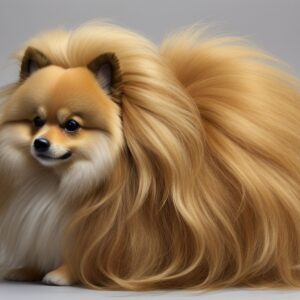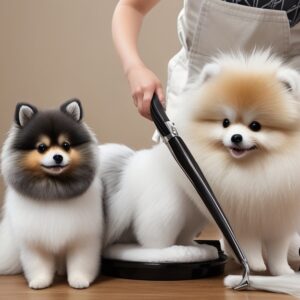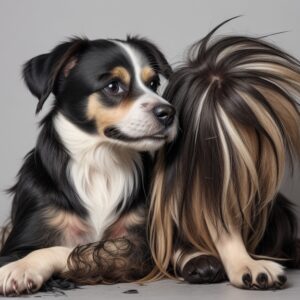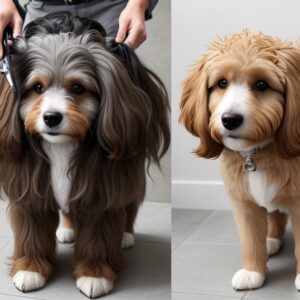Did you know that 68% of pet owners struggle with grooming their dogs? If you’re looking for ways to make the grooming process easier and more enjoyable for both you and your furry friend, you’re in the right place.
In this article, we will share 10 dog grooming hacks that every pet parent should know. From DIY dry shampoo to stress-free nail trimming techniques, these tips and tricks will help keep your dog looking and feeling their best.

Key Takeaways
- DIY grooming solutions can be cost-effective and convenient for pet parents.
- Regular ear cleaning and fur care are important for maintaining a healthy and clean dog.
- Proper nail trimming techniques can help prevent discomfort and injury for dogs.
- General grooming tips such as stress-free bath time, paw care, natural flea and tick prevention, and fresh breath maintenance are essential for overall dog grooming.
DIY Dry Shampoo for Dogs
To effectively maintain the cleanliness and freshness of your dog’s coat between baths, consider using a DIY dry shampoo for dogs. This homemade flea treatment is a convenient and cost-effective way to keep your furry friend’s coat clean and free from unpleasant odors.
Dry shampoo allows you to quickly freshen up your dog’s coat without the need for water or traditional bathing. It is especially useful during colder months or when your dog is unable to have a full bath.
To make your own dry shampoo, simply mix together equal parts of baking soda and cornstarch. Apply the mixture to your dog’s fur using a fine-toothed comb or a brush specifically designed for dogs. This will help distribute the dry shampoo evenly and remove any excess powder.
Now, let’s move on to some easy ear cleaning tips.
Easy Ear Cleaning Tips
How can you effectively clean your dog’s ears to ensure their overall health and well-being?
Here are three easy ear cleaning tips to help you maintain your dog‘s ear health:
- Regular Inspection:
Take the time to inspect your dog’s ears regularly. Look for signs of redness, swelling, discharge, or a foul odor, which may indicate an ear infection or ear mites. Early detection is crucial for prompt treatment.
- Natural Ear Cleaning Solutions:
Instead of using harsh chemicals, opt for natural solutions to clean your dog’s ears. Mix equal parts of apple cider vinegar and water, or use a specialized ear cleaning solution recommended by your veterinarian. Gently wipe the outer part of the ear with a cotton ball soaked in the solution.
- Prevention:
To prevent ear mites, regularly clean your dog’s bedding and vacuum your home. Additionally, avoid exposing your dog to other animals with ear mites. Consult your veterinarian for preventative measures.
By following these easy ear cleaning tips, you can help prevent ear infections and maintain your dog’s overall ear health.
Now, let’s move on to the next section: ‘Tangle-Free Fur: Removing Mats and Tangles’.
Tangle-Free Fur: Removing Mats and Tangles
One effective technique for achieving tangle-free fur on your dog is by employing the method of detangling mats and tangles. To successfully remove these tangles, it is important to have the right grooming tools on hand.
Essential supplies for achieving tangle-free fur include a slicker brush, a wide-toothed comb, and a dematting tool. The slicker brush helps to remove loose hair and prevent matting, while the wide-toothed comb can be used to gently comb through the fur, removing any tangles. In cases of more severe mats, a dematting tool with sharp blades can be used to carefully cut through the mats without harming your dog’s skin.
When using these tools, it is important to be gentle and patient, working through the tangles slowly and carefully. By following these dematting techniques, you can ensure that your dog’s fur remains tangle-free and healthy.
Homemade Doggie Toothpaste
A homemade doggie toothpaste can be a cost-effective and safe option for maintaining your dog’s oral hygiene. Not only does it save you money, but it also allows you to control the ingredients and avoid any harmful additives that may be present in commercial toothpaste.
Here are three simple homemade doggie toothpaste recipes that you can try at home:
- Baking soda and coconut oil: Mix equal parts of baking soda and coconut oil to create a paste. Baking soda helps remove plaque and freshen breath, while coconut oil has antibacterial properties.
- Peanut butter and parsley: Combine peanut butter with fresh parsley, which helps combat bad breath. The peanut butter makes it more appealing to your furry friend.
- Turmeric and water: Turmeric has anti-inflammatory properties and can help promote healthy gums. Mix a small amount of turmeric with water to create a paste.
Quick and Effective Nail Trimming Techniques
To ensure efficient and precise nail trimming for your dog, utilize these expert-approved techniques. When it comes to trimming your dog’s nails, having the right tools is essential. Invest in high-quality dog nail trimming tools such as clippers or grinders that are specifically designed for dogs. These tools will ensure a clean and safe trim. Additionally, it is important to follow professional nail trimming techniques to avoid injury to your dog. Here are three techniques that can help make the process quick and effective:
| Technique | Description | Benefits |
|---|---|---|
| Positive Reinforcement | Rewarding your dog with treats or praise during the nail trimming process. | Creates a positive association with nail trimming, reducing stress and anxiety. |
| Gradual Approach | Gradually introducing your dog to the nail trimming tools. | Helps your dog feel more comfortable and less fearful of the tools. |
| Regular Trimming | Consistently trimming your dog’s nails to maintain their length. | Prevents overgrowth and reduces the risk of nail-related health issues. |
Dealing With Excessive Shedding
Excessive shedding in dogs can be effectively managed through proper grooming techniques and regular maintenance. Here are three tips to help control excessive shedding:
- Shedding control: Best brush types – Invest in a high-quality brush specifically designed for your dog’s coat type. Different breeds have different coat textures and thicknesses, so choose a brush that effectively removes loose hair without causing discomfort. Slicker brushes, deshedding tools, and undercoat rakes are popular options that can help reduce shedding.
- Diet and nutrition: Reducing excessive shedding – A healthy and balanced diet plays a crucial role in preventing excessive shedding. Ensure your dog’s diet includes high-quality protein, fatty acids, and essential nutrients. Omega-3 and Omega-6 fatty acids are particularly beneficial for promoting healthy skin and coat. Consult with your veterinarian to determine the best diet for your dog’s specific needs.
- Regular grooming and maintenance – Regularly groom your dog to remove loose hair and prevent it from ending up all over your house. Brushing your dog’s coat at least once a week can help control shedding and keep their coat healthy. Additionally, regular bathing, using a pet-friendly shampoo, can help remove excess hair and keep their coat clean and shiny.
Natural Solutions for Flea and Tick Prevention
One effective natural solution for flea and tick prevention in dogs is the use of essential oils. Essential oils, derived from plants, have been found to repel fleas and ticks due to their strong smells.
Some commonly used essential oils for this purpose include lavender, lemongrass, peppermint, and cedarwood. To use essential oils as a natural remedy, dilute a few drops of the chosen oil in water and spray it onto your dog’s coat, avoiding the eyes and mouth.
Alternatively, you can add a few drops of the oil to a carrier oil, such as coconut oil, and massage it into your dog’s skin. It is important to note that not all essential oils are safe for dogs, so it is crucial to do thorough research and consult with a veterinarian before using them.
Keeping Your Dog’s Breath Fresh
Using proper dental care is essential for maintaining fresh breath in dogs. Bad breath in dogs can be caused by a build-up of bacteria in their mouths, which can lead to dental issues and other health problems. Here are three tips for preventing bad breath in dogs:
- Regular brushing: Brushing your dog’s teeth regularly with a dog-friendly toothbrush and toothpaste can help remove plaque and tartar buildup, preventing bad breath.
- Dental treats and toys: Offering your dog dental treats or toys designed to promote oral health can help reduce bacteria and freshen their breath. Look for products that are specifically formulated to improve dental hygiene.
- Professional dental cleanings: Regular visits to a veterinarian for professional dental cleanings are crucial for maintaining your dog’s oral health. These cleanings can help remove stubborn plaque and tartar that brushing alone may not be able to eliminate.
Stress-Free Bath Time: Tips and Tricks
To ensure a stress-free bath time for your dog, it is important to follow these tips and tricks.
First and foremost, it is essential to create a calming environment. Start by selecting a quiet and warm location for the bath, away from distractions. Additionally, consider playing soft, soothing music to help relax your dog.
Another helpful tip is to introduce your dog to water gradually, using a gentle approach. Begin by wetting their paws and gradually work your way up their body. This helps to alleviate any anxiety or fear they may have.
Furthermore, using pet-friendly grooming products is crucial. These products are specifically formulated to be gentle on your dog’s skin and coat, reducing the risk of irritation or allergic reactions.
Paw Care: How to Keep Your Dog’s Paws Healthy and Clean
Maintaining healthy and clean paws is crucial for the overall well-being of your dog. Just like humans, dogs can experience paw-related issues that can cause discomfort and pain. By following a few simple steps, you can ensure that your dog’s paws stay healthy and clean.
Here are three important tips to keep in mind:
- Regularly inspect your dog’s paws: Check for any signs of injuries or infections such as cuts, scrapes, or swelling. Promptly address any issues to prevent further complications.
- Keep the paws clean: After walks or outdoor activities, gently clean your dog’s paws with a damp cloth to remove any dirt or debris. This helps prevent paw pad infections and reduces the risk of paw pad cracks.
- Provide proper paw care: Moisturize your dog’s paw pads using a paw balm or petroleum jelly to prevent dryness and cracking. Additionally, trim your dog’s nails regularly to avoid overgrowth and potential injuries.
Conclusion
In conclusion, these 10 dog grooming hacks provide practical and effective solutions for pet parents to maintain their furry friends’ hygiene and health.
From DIY dry shampoo and homemade toothpaste to stress-free bath time and natural flea prevention, these tips offer efficient ways to keep dogs clean and comfortable.
By incorporating these grooming techniques into their routine, pet parents can ensure their dogs’ well-being and enhance the bond between them and their beloved pets.
Remember, a little grooming goes a long way in keeping your dog happy and healthy!






